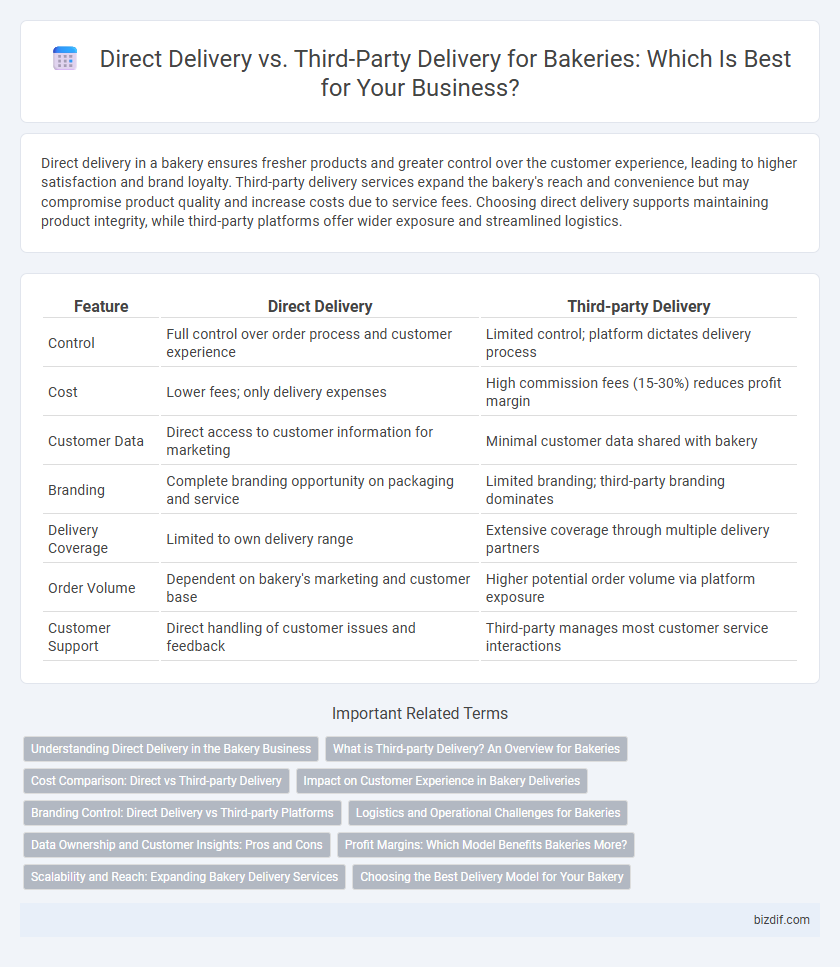Direct delivery in a bakery ensures fresher products and greater control over the customer experience, leading to higher satisfaction and brand loyalty. Third-party delivery services expand the bakery's reach and convenience but may compromise product quality and increase costs due to service fees. Choosing direct delivery supports maintaining product integrity, while third-party platforms offer wider exposure and streamlined logistics.
Table of Comparison
| Feature | Direct Delivery | Third-party Delivery |
|---|---|---|
| Control | Full control over order process and customer experience | Limited control; platform dictates delivery process |
| Cost | Lower fees; only delivery expenses | High commission fees (15-30%) reduces profit margin |
| Customer Data | Direct access to customer information for marketing | Minimal customer data shared with bakery |
| Branding | Complete branding opportunity on packaging and service | Limited branding; third-party branding dominates |
| Delivery Coverage | Limited to own delivery range | Extensive coverage through multiple delivery partners |
| Order Volume | Dependent on bakery's marketing and customer base | Higher potential order volume via platform exposure |
| Customer Support | Direct handling of customer issues and feedback | Third-party manages most customer service interactions |
Understanding Direct Delivery in the Bakery Business
Direct delivery in the bakery business allows fresh, high-quality products to be delivered straight from the bakery to customers, ensuring optimal taste and freshness. This method reduces dependency on third-party logistics, giving bakeries greater control over delivery schedules and customer service standards. Maintaining direct delivery systems enhances brand reputation by guaranteeing timely product arrival and preserving the bakery's unique quality.
What is Third-party Delivery? An Overview for Bakeries
Third-party delivery services refer to external companies that handle the order taking, payment processing, and food delivery for bakeries, allowing them to reach a broader customer base without investing in their own delivery infrastructure. Platforms like Uber Eats, DoorDash, and Grubhub collect a commission fee on each transaction, impacting bakery profit margins but providing valuable marketing exposure and access to diverse customer networks. Utilizing third-party delivery can streamline operations but requires careful consideration of service costs, order accuracy, and maintaining product quality during transport to preserve the bakery's reputation.
Cost Comparison: Direct vs Third-party Delivery
Direct delivery in bakeries typically reduces overall costs by eliminating third-party commissions, which can range from 15% to 30% per order, allowing higher profit margins. Third-party delivery services offer convenience and wider customer reach but often involve fees and surcharges that increase operating expenses significantly. Choosing direct delivery enables bakeries to retain full control over pricing and customer experience while minimizing additional costs associated with intermediaries.
Impact on Customer Experience in Bakery Deliveries
Direct delivery in bakery services enhances customer experience by ensuring fresher products and greater control over order accuracy and timing. Third-party delivery introduces wider reach and convenience but can compromise product freshness and lead to delayed or mishandled orders. Prioritizing direct delivery streamlines communication and preserves bakery product quality, resulting in higher customer satisfaction.
Branding Control: Direct Delivery vs Third-party Platforms
Direct delivery allows bakeries to maintain full branding control, ensuring consistent customer experience through personalized packaging and direct communication. Third-party delivery platforms often limit branding opportunities, as orders are processed under the platform's interface, reducing the bakery's visibility. Strong branding control in direct delivery builds customer loyalty and reinforces the bakery's unique identity.
Logistics and Operational Challenges for Bakeries
Direct delivery enables bakeries to maintain quality control and freshness by managing logistics internally, but it requires investment in delivery infrastructure and staff training. Third-party delivery services offer expanded reach and convenience but often come with higher fees and reduced control over order accuracy and customer experience. Operational challenges include coordinating timely dispatches, handling peak order volumes, and maintaining consistent packaging standards to preserve product integrity during transit.
Data Ownership and Customer Insights: Pros and Cons
Direct delivery in bakeries ensures full control over customer data, enabling personalized marketing and improved customer insights, but demands higher operational resources. Third-party delivery offers convenience and wider reach but limits access to customer information, restricting the bakery's ability to build direct relationships and optimize marketing strategies. Data ownership in direct delivery fosters stronger brand loyalty, while third-party services may sacrifice long-term customer insights for short-term sales growth.
Profit Margins: Which Model Benefits Bakeries More?
Direct delivery allows bakeries to retain higher profit margins by eliminating third-party commissions, which can range from 15% to 30% per order. Third-party delivery platforms offer convenience and expanded customer reach but often reduce profitability due to fees and limited control over pricing. Maximizing profit margins typically favors direct delivery as it preserves revenue and strengthens customer relationships.
Scalability and Reach: Expanding Bakery Delivery Services
Direct delivery allows bakeries to maintain full control over customer experience and ensure product freshness, but scalability is limited by internal resources and geographic reach. Third-party delivery services offer immediate access to a wider customer base and expanded delivery radius, leveraging established logistics and marketing networks. Balancing in-house delivery with third-party platforms optimizes scalability and broadens market reach without compromising quality.
Choosing the Best Delivery Model for Your Bakery
Direct delivery offers bakeries complete control over order quality, customer interaction, and brand experience, ensuring products like fresh pastries and artisan bread arrive perfectly. Third-party delivery services expand reach quickly, tapping into established customer bases and providing convenient order management, though often at the cost of higher fees and reduced control. Evaluating factors such as order volume, delivery radius, customer service priorities, and profit margins helps determine whether in-house delivery or third-party platforms best align with your bakery's growth strategy.
Direct Delivery vs Third-party Delivery Infographic

 bizdif.com
bizdif.com